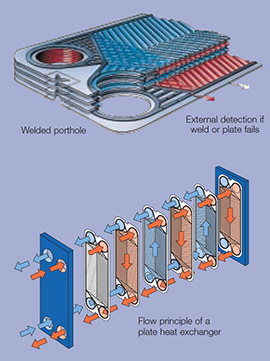Double Wall Plate Heat Exchanger
Design and construction
The Double-Wall Plate Heat Exchanger works on the same principle as a conventional plate heat exchanger but differs in that the single plates between the two media are replaced by plate pairs consisting of two identical plates stacked on top of each other and welded around the portholes. The channels then formed by assembling welded plate pairs in a plate pack are conventional channels sealed by gaskets in the traditional manner. In the unlikely event of leakage of any cause, one of the two media will always appear externally. Should a failure occur, whether it is related to the plate, gasket or seal weld, the ensuing leak will be easily visible on the outside of the heat exchanger.
For example:
- A hole in one of the double plates will result in external leakage from between the double-plate pair.
- A gasket defect will cause an external leak, either directly from the peripheral gasket or from the gasket vents open to the atmosphere.
- A defect weld will cause external leakage to appear either from the gasket vents or from between the plates at the site of the failure.
Advantages of the Double-Wall Plate Heat Exchanger
The Double Wall Plate Heat Exchanger, has many advantages over double-wall shell-and-tube heat exchangers:
- compact, small dimensions
- low weight
- low hold-up volume
- easy maintenance
- few inspections required
- easy to extend or reduce heat transfer area
- corrosion-resistance
- low fouling
- robust and reliable
- lower investment cost
- lower operating cost
Examples of duties for the Double-Wall Plate Heat Exchanger
Transformer oil cooling
Water-contaminating transformer oil can result in severe damage to the transformer and can necessitate lengthy plant shutdowns.
Lube oil cooling
Oil which pollutes the cooling medium, whether it is sea, lake or river water, can cause severe damage to the environment and if the cooling medium mixes with the oil, serious damage can be caused to the equipment being cooled.
Quench oil cooling
Water mixing with quench oil can cause a steam explosion.
Potable water heating
District heating water, glycol, refrigerants and other heat sources used for heating potable water must not pollute the tap-water system.
Chemical processes
Intermixing of process media can create accelerated corrosion, an explosion, undesirable chemical reactions or contamination.
For example:
- An undesirable chemical reaction occurs if lauryl lactam or caprolactam intermixes with water, resulting in a miscolored product (fluorescence).
- Accelerated corrosion results in chlorated hydrocarbons intermix with water to produce hydrochloric acid.
Environmental protection
- Elimination of the risk of contamination of the cooling media in direct cooling systems.
- Replacement of existing secondary cooling systems.
- Waste water treatment with water of unknown composition allows thinner plate thickness.
Food and pharmaceutical processing
Product intermixing with the other media totally contaminates final products.
Alfa Laval® – thermal engineering pioneers
The Double-Wall Plate Heat Exchanger was developed by Alfa Laval in response to power stations’ problems of how to safeguard transformers from the risk of oil and water mixing, in case of heat exchanger failure. With the introduction of the Double-Wall Heat Exchanger to the product range, Alfa Laval has extended the limits of the plate heat exchanger to new applications. This plate heat exchanger is just one of Alfa Laval’s thermal developments. Other recent developments are the graphite plate heat exchanger for highly corrosive liquids, the Semi-welded Heat Exchanger, a welded plate heat exchanger for high-temperature corrosive media, and the Wide-Gap Plate Heat Exchanger.

